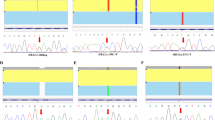Abstract
Hereditary spherocytosis (HS) with hemolysis, splenomegaly, and jaundice as the main clinical symptoms varied in different population and SPTB mutated rate is common except for ANK1 in the Chinese population, whereas only a few studies have been reported. Here, 11 Chinese pediatric patients with newly SPTB mutations detected by targeted next generation sequencing technology were included and analyzed in our study. The characteristics of mutation separation were verified among family members by bidirectional Sanger sequencing. The detected 11 mutations were novel, all of which were heterozygotes, including five de novo mutations, five maternal mutations, and one paternal mutation. Meanwhile, the 11 different novel mutation sites distributed on and near the seven exons included four pathogenic sites and seven likely pathogenic sites. The detection of 11 novel mutation sites gene expanded the mutant spectrum of the SPTB gene, and provided corresponding clinical data, which laid a foundation for the subsequent studies on HS in Chinese population, especially in pediatric patients.
This is a preview of subscription content, access via your institution
Access options
Subscribe to this journal
Receive 12 print issues and online access
$259.00 per year
only $21.58 per issue
Buy this article
- Purchase on Springer Link
- Instant access to full article PDF
Prices may be subject to local taxes which are calculated during checkout


Similar content being viewed by others
References
Gallagher PG, Forget BG. Hematologically important mutations: spectrin and ankyrin variants in hereditary spherocytosis. Blood Cells Mol Dis. 1998;24:539–43.
Wang R, Yang S, Xu M, Huang J, Liu H, Gu W, et al. Exome sequencing confirms molecular diagnoses in 38 Chinese families with hereditary spherocytosis. Sci China Life Sci. 2018;61:947–53.
Park J, Jeong DC, Yoo J, Jang W, Chae H, Kim J, et al. Mutational characteristics of ANK1 and SPTB genes in hereditary spherocytosis. Clin Genet. 2016;90:69–78.
Xue J, He Q, Xie XJ, Su AL, Cao SB. A clinical and experimental study of adult hereditary spherocytosis in the Chinese population. Kaohsiung J Med Sci. 2020;36:552–60.
Qin L, Nie Y, Zhang H, Chen L, Zhang D, Lin Y, et al. Identification of new mutations in patients with hereditary spherocytosis by next-generation sequencing. J Hum Genet. 2020;65:427–34.
Peng GX, Yang WR, Zhao X, Jin LP, Zhang L, Zhou K, et al. The characteristic of hereditary spherocytosis related gene mutation in 37 Chinese hereditary spherocytisis patients. Zhonghua Xue Ye Xue Za Zhi. 2018;39:898–903.
Bolton-Maggs PH, Stevens RF, Dodd NJ, Lamont G, Tittensor P, King MJ. General haematology task force of the British Committee for standards in haematology. Guidelines for the diagnosis and management of hereditary spherocytosis. Br J Haematol. 2004;126:455–74.
Marcel Martin. Cutadapt removes adapter sequences from high-throughput sequencing reads. Embnet J. 2011;17:10–12.
Li H, Durbin R. Fast and accurate short read alignment with Burrows-Wheeler transform. Bioinformatics 2009;25:1754–60.
McKenna A, Hanna M, Banks E, Sivachenko A, Cibulskis K, Kernytsky A, et al. The genome analysis toolkit: a MapReduce framework for analyzing next-generation DNA sequencing data. Genome Res. 2010;20:1297–303.
Wang K, Li M, Hakonarson H. ANNOVAR: functional annotation of genetic variants from high-throughput sequencing data. Nucleic Acids Res. 2010;38:e164.
Jaganathan K, Kyriazopoulou Panagiotopoulou S, McRae JF, Darbandi SF, Knowles D, Li Y, et al. Predicting splicing from primary sequence with deep learning. Cell. 2019;176:e24,535–48.
Perrotta S, Gallagher PG, Mohandas N. Hereditary spherocytosis. Lancet. 2008;372:1411–26.
van Vuren A, van der Zwaag B, Huisjes R, Lak N, Bierings M, Gerritsen E, et al. The complexity of genotype-phenotype correlations in hereditary spherocytosis: a cohort of 95 patients: genotype-phenotype correlation in hereditary spherocytosis. Hemasphere. 2019;3:e276.
Maillet P, Alloisio N, Morlé L, Delaunay J. Spectrin mutations in hereditary elliptocytosis and hereditary spherocytosis. Hum Mutat. 1996;8:97–107.
Ittiwut C, Natesirinilkul R, Tongprasert F, Sathitsamitphong L, Choed-Amphai C, Fanhchaksai K, et al. Novel mutations in SPTA1 and SPTB identified by whole exome sequencing in eight Thai families with hereditary pyropoikilocytosis presenting with severe fetal and neonatal anaemia. Br J Haematol. 2019;185:578–82.
Acknowledgements
We appreciate all members who participated in this study. This work was supported by Chongqing Municipal Science and Technology Commission Fundamental Research funded project (Grant No: cstc2019jxjl0087) and NHC Key Laboratory of Birth Defects and Reproductive Health (Grant No: 1615).
Author information
Authors and Affiliations
Contributions
J.F., S.H., and Y.Z. conceived the idea for the study. L.Y., Y.Y., Y.S., Y.T., L.M., L.C., L.Z., and S.Q. performed or supervised laboratory work. L.Y. and D.L. analyzed the data. J.F. and L.Y. wrote and edited the manuscript.
Corresponding authors
Ethics declarations
Conflict of interest
The authors declare no competing interests.
Additional information
Publisher’s note Springer Nature remains neutral with regard to jurisdictional claims in published maps and institutional affiliations.
Rights and permissions
About this article
Cite this article
Fan, J., Yao, L., Lu, D. et al. The updated beta-spectrin mutations in patients with hereditary spherocytosis by targeted next-generation sequencing. J Hum Genet 66, 1153–1158 (2021). https://doi.org/10.1038/s10038-021-00946-6
Received:
Accepted:
Published:
Issue Date:
DOI: https://doi.org/10.1038/s10038-021-00946-6



